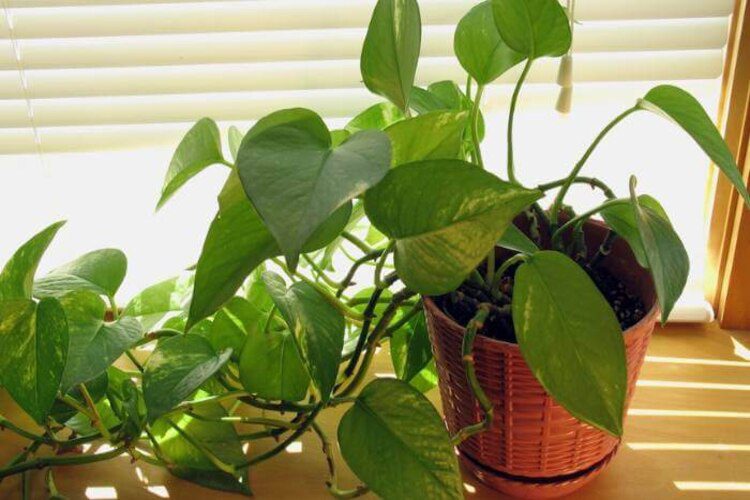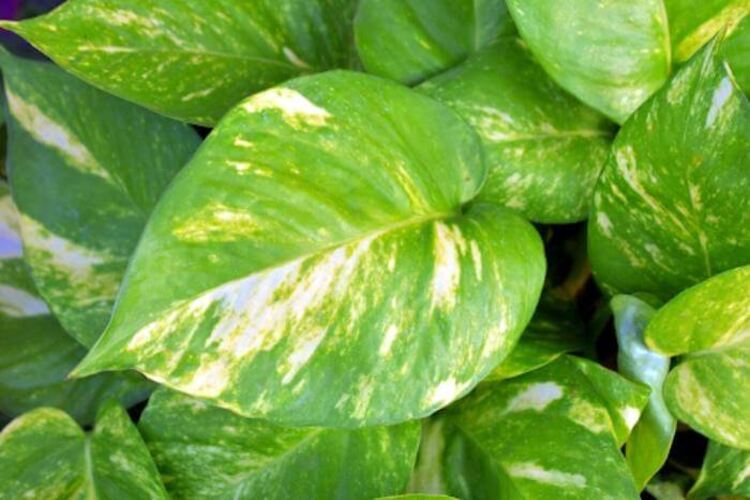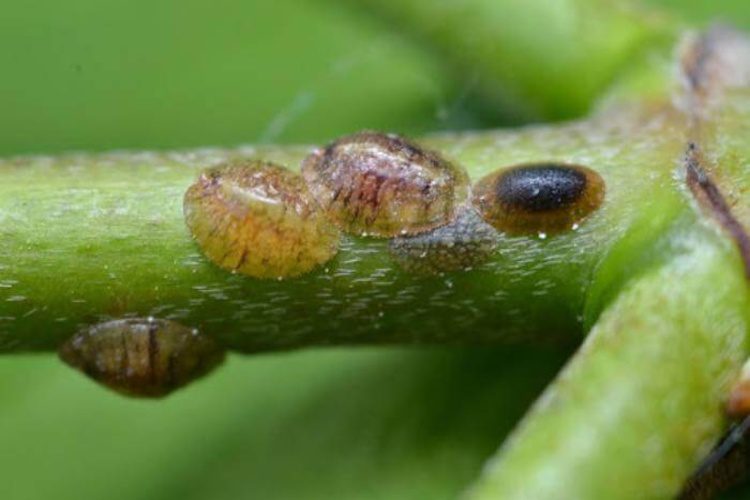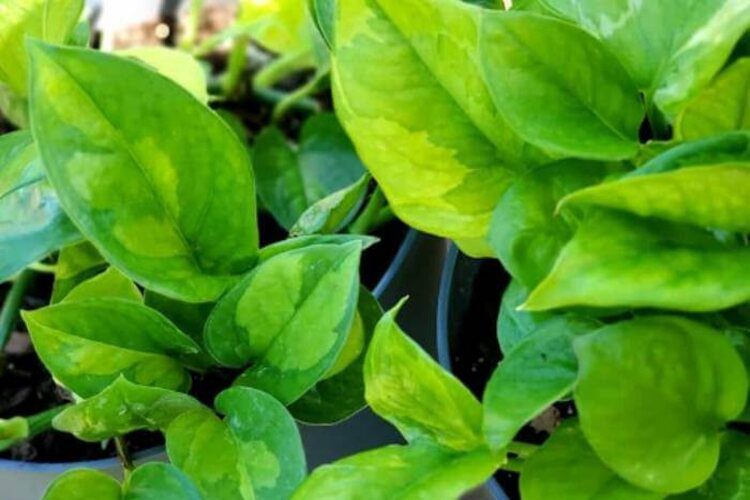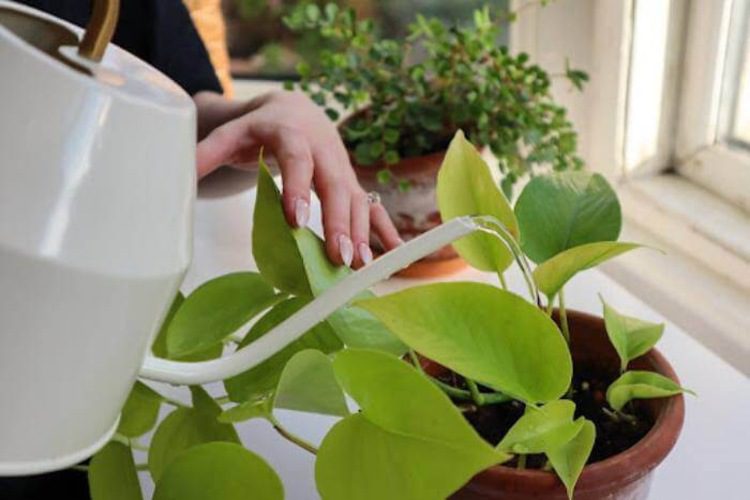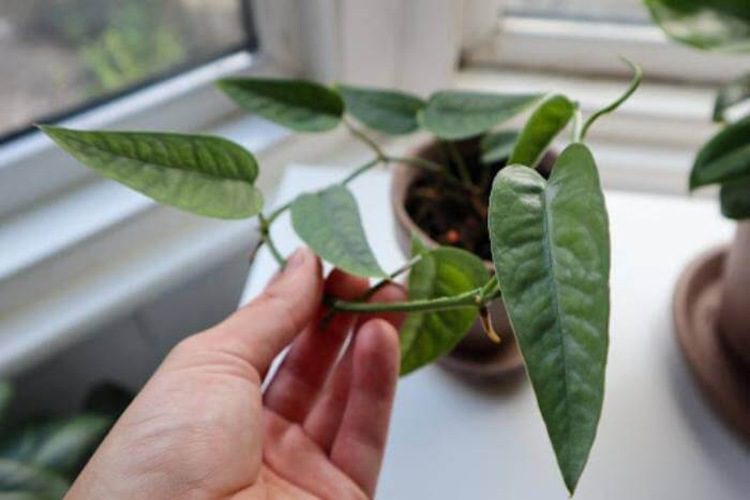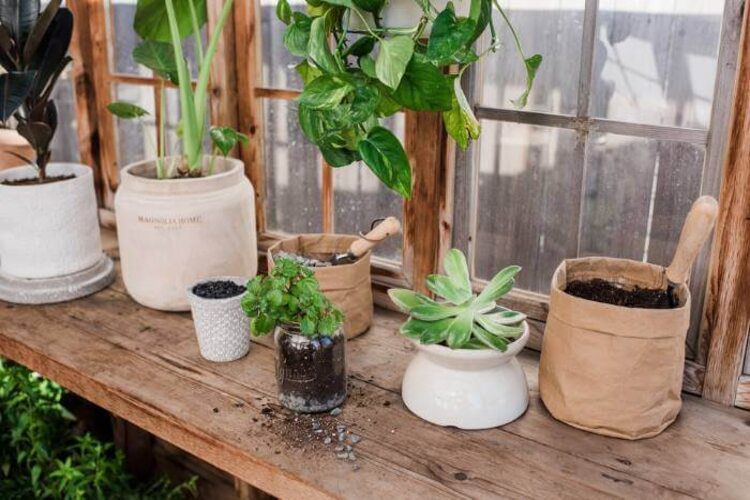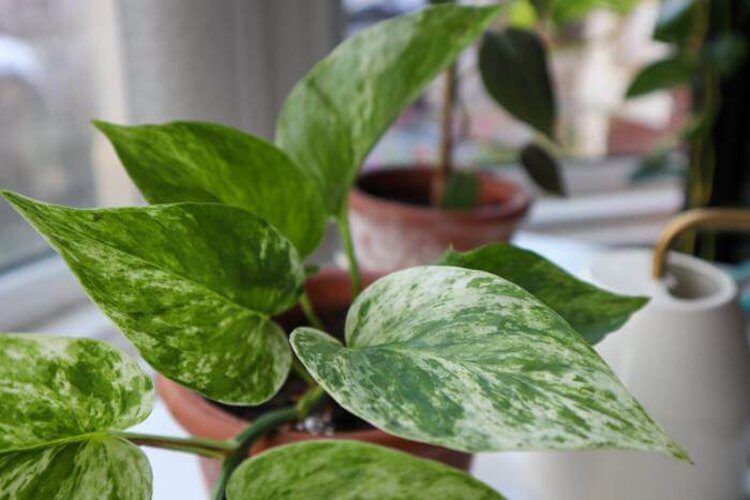18 Common Pothos Problems You Should Know
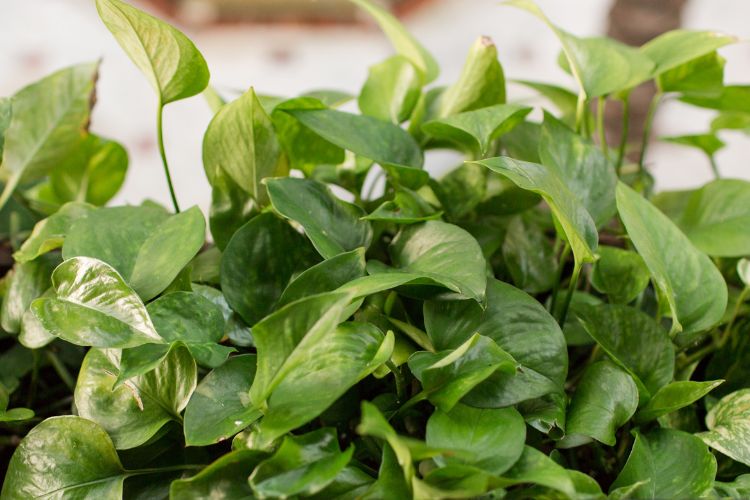
Another incredible benefit is that they can filter toxins from the air. However, several problems still occur to your Pothos in the growing process. You might need to detect it carefully, determine the causes, and apply the appropriate treatment to recover its good condition.
Leaves turn yellow
Leaves turning yellow might be the first noticeable sign that your Pothos are having problems. The solid, usually dark green foliage starts to develop patches of yellow, which don’t look healthy. It usually takes place on some parts of the leaves first and spreads through the whole plant as time passes.
There are some possible causes of the care style or the environment that you can fix. For example, if you overwater it, the root cells will be damaged and not let the plant receive the energy it needs, so it turns yellow. If it is placed in direct sunlight for too long, the leaves will become yellow all over and collapse due to burning. Check out our post on Pothos leaves turning yellow to learn about any other reasons and how to fix them.
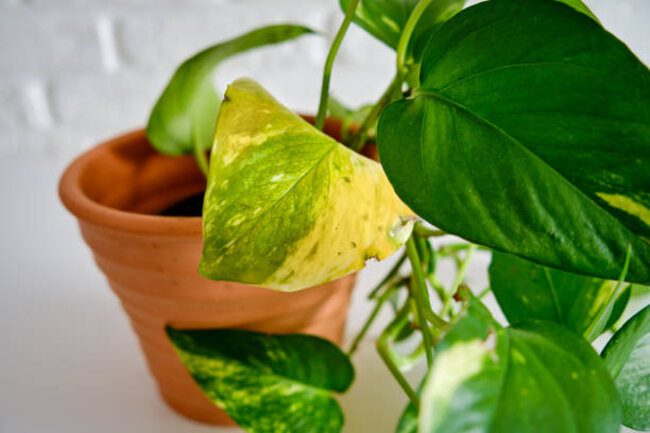
Leaves turn brown
Another severe case is the Pothos leaves turning brown. This is the more profound stage of turning yellow. It is due to a wide range of environmental factors that affect the plant. Overwatering or direct light exposure should be two of the leading causes. Besides, we should check the humidity, temperature, and size of the pot that bears the plant.
Pothos is a tropical breed of plant that adapts to quite humid atmospheres, so being too dry will stress it. Also, the ideal temperature range for any Pothos is from 65 degrees Fahrenheit to 85 degrees Fahrenheit, so make sure your room matches the requirements. You might also notice that Pothos don’t need much fertiliser because they’re low-maintenance. Excess calcium will cause an imbalance in the plants and impair the leaves.
You should also check if your plant has been rootbound, meaning that it has grown too big for the pot. Pothos has a quick growth rate, so after two years or so, the roots can easily spill the pot, making it hard to absorb the nutrients and water. When this is the case, detect and trim off the affected roots and foliage, and finally move it to another larger pot with new soil.

Brown spots
If the leaves change colour but appear as brown spots and tips rather than large patches, your Pothos likely has fungal leaf spots or some common diseases like Southern Blight or Bacterial Wilt. It is contagious, so when you recognise it, cut off the affected leaves and isolate the plant from other healthy indoor plants of yours. Then you treat it by adding dome fungicide or chemicals to “clean” your Pothos.
Also, over-fertilizing is likely to cause tips on the plant due to accumulating salts. Try to fertilize it less frequently, ideally once a month, and after each time, give it more water and time to flush out all the salts and excess elements.
Check for the condition of the light; if there is a side of the Pothos that gets more brown tips than the other sides. Presumably, it is because of abundant sunlight that the plant doesn’t require much.
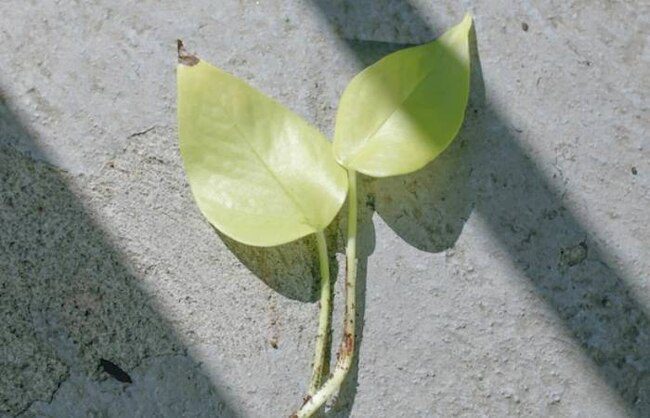
Shoot blackening
If the color of your Pothos quickly turns into a shade of black and completely dies out, it would be the last plea of your plant. When the leaves turn black, you can hardly save or recover them to their original state. Root rot is the top killer of plants, and this calamity is usually due to overwatering for a long time. Once the root is rotted, the plant can’t take in any water or nutrients to maintain its life, and as a result, it collapses.
Sunburn could also create dark spots, so ensure you aren’t exposed to intense sunlight for a long time. You can troubleshoot blackening leaves by repotting: after trimming all the ruined leaves, change the plant’s container by stripping all the rotten roots, change the damp soil to a whole new one, and plan on careful care for recovering Pothos.

Leaves falling
Pothos leaves don’t regularly fall off unless there is some stress from the environment. Underwatering causes leaves to fall, which is necessary to decrease the demand for water for the whole plant. It’s hard to recognize if it lacks water since Pothos take weeks to need watering again. The best way is to check whether the soil’s top inch has dried out.
The shock from cold temperatures and overly dry air can cause your Pothos to lose leaves because Pothos is a tropical plant that prefers warm and somewhat moist environments to thrive. There is not much you can do to recover the leaves on the fallen ones, but trimming those new exposed spots will make them more likely to grow fresh leaves if you adjust the care and give them what they need.
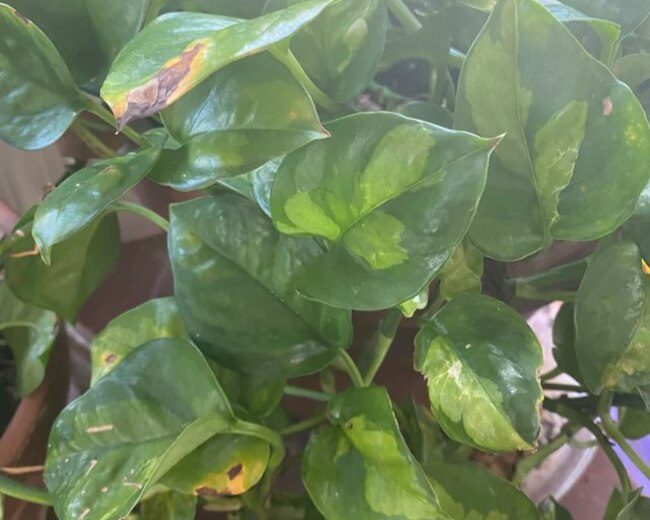
Water dripping
Many people deem water dripping from Pothos leaves something worth worrying about, but it’s a normal healing response of the Pothos. Briefly imagine that it is like the transpiration process of a plant. When your plant is taking in more water than it needs, it pushes the excess water through the surface of the leaves.
The water taken in can be from overwatering, which is lucky enough because your plant did not get root rot but released excess water instead, or it can be from the too-high humidity of the air around it. So we don’t need to worry about the water drops on the leaves, but about the effect that comes after. Overwatering or too much moisture will damage your Pothos soon enough if you don’t fix it.

Curling leaves
It is easier to fix than other problems like showing, wilting, or curling leaves, which usually result from inappropriate water or light supplements. If you water your Pothos too irregularly or keep them in dark places in your house for too long, the plant wilts as it has little energy to erect straightly, and the leaves curl or deform as a sign of energy withdrawal.
It’s not good when Pothos receive too much water or light, especially direct daylight. Because Pothos is very low-maintenance, it can bear a little neglect rather than a little extreme neglect. Once it stands in direct sunlight, it will get stressed out, damaged, and shrunk.
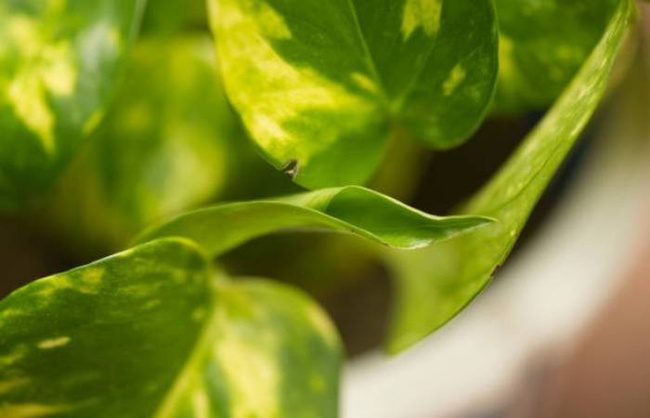
Drooping plants
Drooping is also a common problem in Pothos. The plant is sagging and leaning, not as erect and vivid as it used to be. Again, the top reason for this case has been neglected for too long. Too little water intake and a dull light source make the whole plant droop.
To cure this, give it more of what it needs, but on a gradual basis, because if you “pour” a bucket of water on it or place it in the sun for a whole day, it will die out even faster. Or you can check for root bound; if the roots have grown too large for the pot, it can’t take in the nutrients well and, as a result, will withdraw by changing the shape.
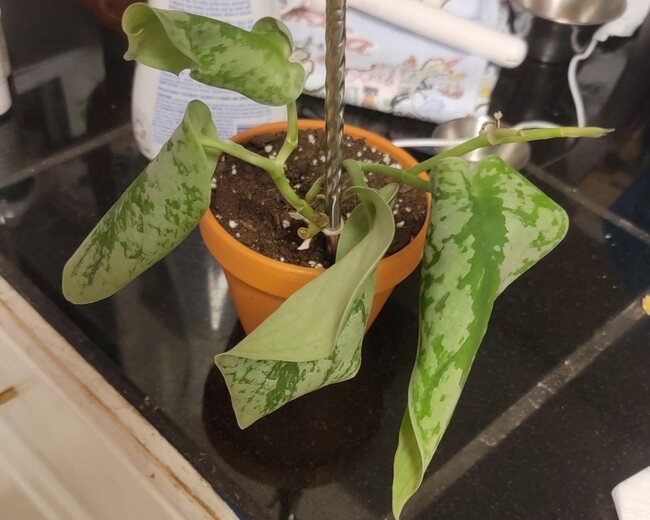
Leaves turning white or bleaching
Pothos has a distinct, lush color. While the leaves are turning uniform white, the difference is defined by the variegation patterns. But sometimes the colour or variegation on some leaves appears whiter and paler.
Pothos like this seems to be discoloured or bleached. It is likely because it’s not getting enough light or is placed in a very low-light condition. Some Pothos with more white variegation will have less chlorophyll, which means they will absorb less light than normal ones and thus need to be in more light than normal green Pothos. Or else they will bleach their color.

Stunted
If you notice that your Pothos is not growing normally, it stops growing or grows unequally on all parts. At first, you should doubt it as some signs of pest infestation; your plant might not get enough nutrients for growing because the pests that invaded the plant have sucked all the sap out.
And it is easy enough to discover; observe each leaf to see if there are any peculiar dots. They can be scales, aphids, or red spider mites. Use regular insecticidal soap or neem oil to eliminate them quickly. You will see your Pothos retrieving its large leaves and trailing long vines.
Another possible cause is that it is starving. Pothos usually don’t require many nutrients to thrive, but super arid soil is not ideal for growing its best. So if your plant is not growing appropriately, try to fertilize more regularly with a balanced compost of N-P-K in equal ratios, betting you will see a better result.
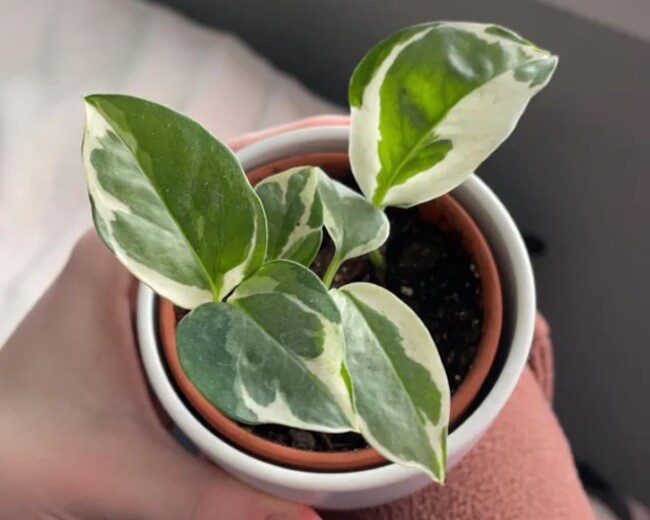
Small leaves
The size of the leaves depends on the variety of Pothos. Indoor Pothos leaves usually grow to a length of 4-8 inches. When reaching maturity, you should notice something is wrong if it is smaller than this range.
Usually, when its leave’s growth is small due to lousy growth, it will also have other irregular signs, such as yellowing or curling. Growing smaller is the plant’s response to stress. It could be treated with poor conditions; check if you have watered it enough or given it enough indirect light it needs in a day. On the other hand, being overwhelmed by those two necessary life sources would also harm Pothos. This action numbs the plant and hinders it from absorbing the nutrients, and as a result, it does not grow larger.
Another possible cause is that pests and insects are attacking the leaves; those creatures suck out the sap and nutrients that cease the leaves’ growth. Whatever the reason, your Pothos might be having some trouble with daily care that you should adjust before they get damaged more severely, like curling or turning brown.

White powdery spots
Unlike any other problems of Pothos, which result from many common causes like underwatering or too much low light, this problem of Pothos is unique because a particular culprit caused it, pests and insects, specifically powdery mildew, mealybugs, and spider mites.
These pests or insects have usually covered themselves in armours that appear as white powders. The white powders not only affect the evergreen look of Pothos but also threaten the plant’s health. These annoying white pests could also spread to other parts and adjacent plants.
So when you notice these, you should apply treatment immediately. You can either prune the affected leaves or use a cotton swab soaked in cotton to wipe the insects down the leaves. If everything doesn’t work, you can resort to organic fungicides for safe pest removal.

Lack of variegation
You decided to have a Pothos in your house because of its beautiful variegation, but for some reason, your Pothos lost this feature as time went on and left a tedious whole green foliage. The cause usually lies in the lack of light. Variegation is the fact that the plants are devoid of some chlorophyll pigment, which forms the green shade of the leaves, the zones with white streaks or splashes are the most lacking or non-chlorophyll areas.
The chlorophyll pigment is to help the plant photosynthesize more straightforwardly. And if there is little light available, the leaves will summon more chlorophyll to compensate for the too-low light supplement and hence survive. This feature is a mutation on Pothos but is considered attractive, so you should retrieve it. Bring it to more light exposure places and trim the so-green leaves to allow the new variegated leaves to grow.
Pothos with much-variegated features also grow more slowly than normal ones, so they might require a bit more care to thrive with dynamic streaks and patches.
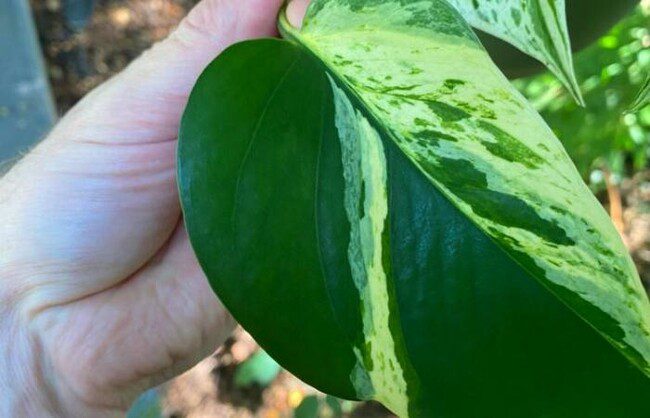
Sunburn
When an indoor plant leaf is exposed to direct sunlight for an extended period of time, it may become burned. The strong heat makes the leaves dry out quickly, which makes them crispy and brown. Sunburn is most often caused by too much direct sunlight, but it can also happen when your Pothos have trouble with humidity (low humidity makes it hard for the plant to recover) or temperature (high temperatures make plants lose water faster).

Holes in pothos leaves
Bacterial, fungal, and virus infections can harm your Pothos plant, causing ugly holes in its foliage. The most prevalent cause of holes in Pothos leaves, however, is that the soil is infested with leaf-mining flies. Leaf miners include Liriomyza melanogaster. That is, they burrow tunnels into the leaf tissue during feeding and egg-laying.
Leaf-mining larvae are the true cause of holes. As the larvae mature, their size increases, forcing the leaf mines to expand as well. The tips of leaf mines are often tightly coiling, uneven, and blotchy. Physical impacts are another possible reason. When your Pothos leaves were young, they were infrequently injured. The holes will form in the damaged regions as your plant matures.
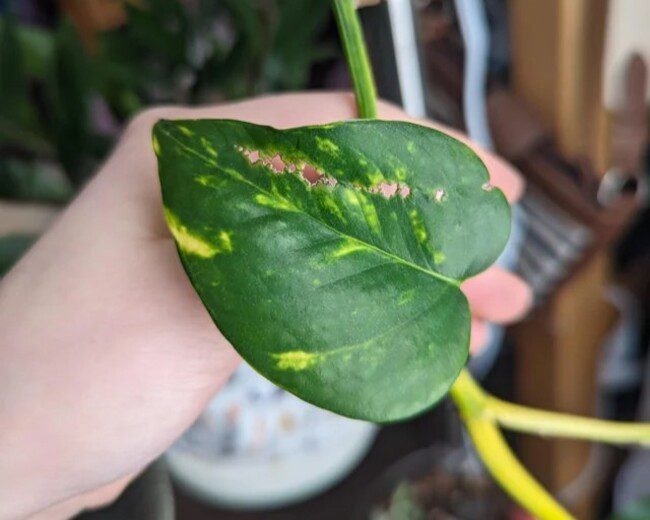
Pothos leggy
In the plant world, “leggy” refers to a plant with a long stem yet only a few leaves. It can have “naked” or leafless branches. This is a regular issue with hanging basket plants like Pothos. In this instance, the plants may trail downhill.
A leggy Pothos has lengthy, sparingly leafed vines. It spends much of its growing cycle producing tall stems instead of new roots or leaves. This leggy condition has several reasons. The most obvious cause is that you have been mistreating your Pothos for a long time.
Overwatering causes the stems to become saturated with water and grow elongated, whereas a lack of light leads the plant to stretch in order to reach the light source. Not pruning the plant is equally to blame, just as not trimming your hair causes it to grow more thinly. Repair these flaws immediately and wait patiently for your Pothos to recover and grow healthily again. If you live in a low-light area, you may also need to consider buying a grow light to help your plant thrive.
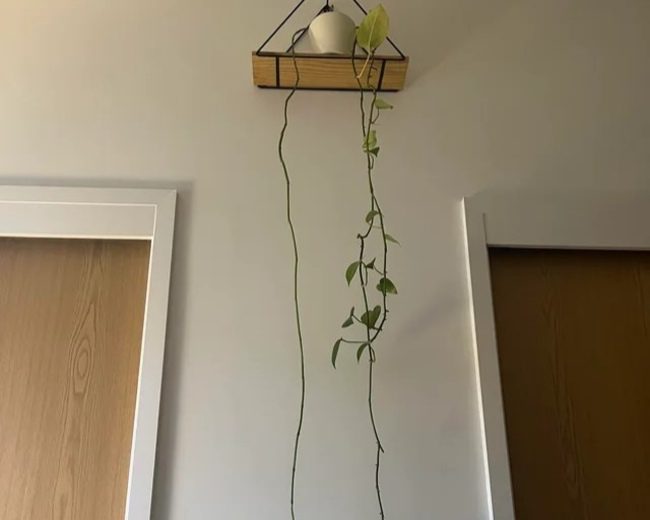
Aerial root
One of the most intriguing and distinguishing aspects of plants is their aerial roots. They emerge above the ground and frequently cling to walls or trellises. Aerial roots on Pothos are the roots that grow from the plant’s stem and above the soil surface. This kind of support is necessary for epiphytes and climbing plants to cling to a structure and develop. Also, they help plants obtain more water, oxygen, and nutrients.
Some people even try to encourage their growth. Meanwhile, some people are unsure how to cope with them when they affect the aesthetic of the Pothos’ look. When these roots do not appear attractive above the potting soil, cutting them off at the nodes is the simplest technique to remove aerial roots.

Overwater/ Underwater
Your plant will have serious problems with water issues, both over and underwater affecting your Pothos’ growth in negative ways. The most common and serious effect of overwatering is root rot. Being saturated with water might cause the roots to choke because they couldn’t get in any oxygen or nutrients. As a result, the leaves will turn yellow, the foliage will droop, and additionally, the soil will not smell good due to the infestation of pests or disease in the roots.
Although your Pothos is more prone to overwatering. It’s also harmful when you forget to water your Pothos for too long. When the roots become severely dry, the vines will appear limp. This condition can be attributed to a lack of water in its cellular system.
Is your Pothos plant dying of thirst? After inspecting your plant for symptoms such as yellow and brown leaves or poor soil, fix it right away so it will recover quickly. It is critical to water the plant on a regular basis while maintaining perfect environmental conditions. To check if the Pothos plant needs water, stick your finger three to four inches into the dirt towards the plant’s base. If your finger is dry and clean, it means your plant requires water. And if your finger seems dirty with soil on it, the plant still has some moisture and does not need to be watered.
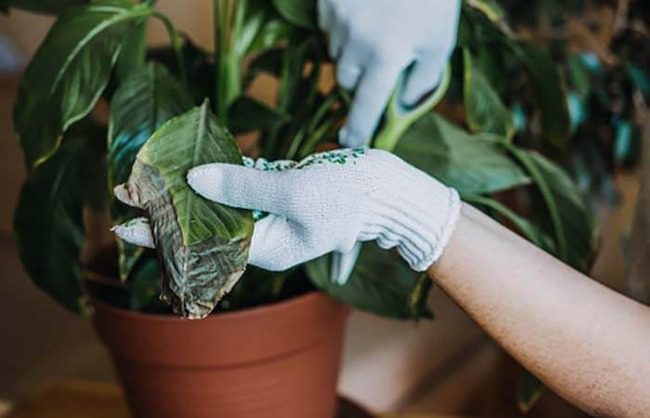
FAQs


